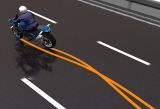To ABS or not to ABS?
 One of the latest safety innovations for motorcycles in the last few years is ABS brakes. ABS stands for Antilock Braking System. What it does is electronically monitor the wheel speed of both wheels and when it detects a deceleration rate that is too fast (such as when the wheel is about to lock from too much brake being applied) it automatically pulses the brake pressure about 10 times per second to maintain optimal braking traction at that wheel. What this essentially does is take out the human error factor of braking too hard and locking up the wheel which can cause loss of control or not braking hard enough and not stopping in a short enough distance to avoid a crash. With ABS, the rider can apply full force to the brake pedal/lever without fear of going in to a skid, but they still need to practice safe braking techniques and get the bike straightened up before starting the braking process. It would be very difficult for the average rider to match the stopping power of a bike equipped with ABS, especially in a panic situation when adrenalin comes into play and the rider inadvertently applies too much brake and causes a skid. Some professional riders may be able to beat the stopping distance of ABS in good conditions, but if you throw in less than perfect conditions such as a wet road surface or sand or gravel on the road, this is where ABS really shines and most riders could not stop a bike in a shorter distance without it. Studies have shown that ABS decreases the chance of a fatal crash by about 1/3.
One of the latest safety innovations for motorcycles in the last few years is ABS brakes. ABS stands for Antilock Braking System. What it does is electronically monitor the wheel speed of both wheels and when it detects a deceleration rate that is too fast (such as when the wheel is about to lock from too much brake being applied) it automatically pulses the brake pressure about 10 times per second to maintain optimal braking traction at that wheel. What this essentially does is take out the human error factor of braking too hard and locking up the wheel which can cause loss of control or not braking hard enough and not stopping in a short enough distance to avoid a crash. With ABS, the rider can apply full force to the brake pedal/lever without fear of going in to a skid, but they still need to practice safe braking techniques and get the bike straightened up before starting the braking process. It would be very difficult for the average rider to match the stopping power of a bike equipped with ABS, especially in a panic situation when adrenalin comes into play and the rider inadvertently applies too much brake and causes a skid. Some professional riders may be able to beat the stopping distance of ABS in good conditions, but if you throw in less than perfect conditions such as a wet road surface or sand or gravel on the road, this is where ABS really shines and most riders could not stop a bike in a shorter distance without it. Studies have shown that ABS decreases the chance of a fatal crash by about 1/3.
An antilock braking system works by constantly measuring wheel speed. One common way to do this is with a small grooved ring near the brake disc often called a tone wheel. The wheel speed sensor sends the tone wheel readings to the ABS unit, which can determine whether the wheel is about to stop rotating. If it is, wheel speed information is used to adjust the pressure from the brake cylinder on the brake caliper multiple times per second.
Currently, ABS is standard on some larger bikes and offered as an option on mid-level bikes. Manufacturers are beginning to realize that where ABS is most needed is on entry level bikes and are offering it as an option on those as well. If you have a bike that is equipped with ABS, you’re ahead of the game. But, if you find yourself in the market for a new bike, you may want to really consider one equipped with ABS.
Safe riding





